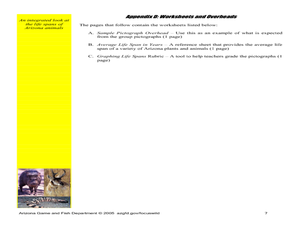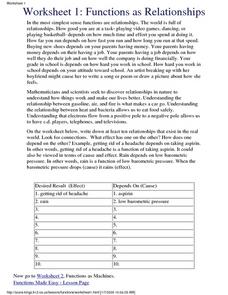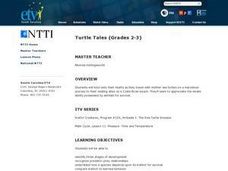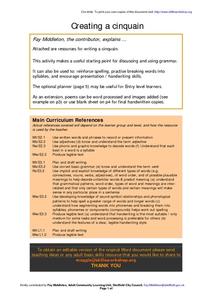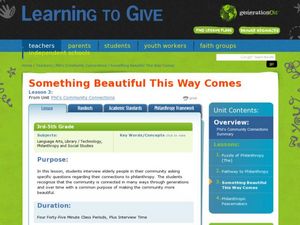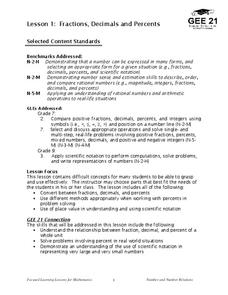Curated OER
Charting Animal Life Spans
Second graders research animal life spans and complete related math activities. In this life span lesson, 2nd graders read How Many Candles and discuss life spans. Students arrange animal cards based on their life spans. Students find...
Curated OER
Characteristics of Energy
Students explore Earth science by completing energy worksheets in class. In this energy forms lesson plan, students identify and define a list of energy vocabulary terms and a K-W-L chart. Students view a matter video clip in class and...
Curated OER
Computer Security Day
In this computer security day worksheet, students match phrases, fill in the blanks, choose the correct words, unscramble words and sentences, write discussion questions and conduct a survey.
Curated OER
Functions As Relationships
In this algebra worksheet, high schoolers read the information about the relationships of functions and then they fill in the graphic organizer with the information at the bottom of the page.
Curated OER
Turtle Tales
Students watch videos and fill out worksheets about the turtles and their journey to the Costa Rican beach. In this turtles lesson plan, students learn and discuss survival, predator and prey, and stages of development.
Curated OER
Describing an Object's Position
Pupils explore language arts by participating in a shape identification activity. In this geometry shape lesson, students discuss the vocabulary terms used to describe the location of an object. Pupils complete a worksheet based upon...
Curated OER
The Microscope
Students investigate the parts and functions of a compound microscope. They explore various websites, label the parts of a microscope on a worksheet, view prepared slides, and create drawings of the prepared slides.
Curated OER
Graphing Activity
In this probability and statistics worksheet, students work with a family member to construct graphs based on real life data. The two page worksheet contains three questions. Answers are not included.
Curated OER
Clues to Copying the Code
For this DNA worksheet, students access a website to determine the information that was used to understand DNA replication. Students compare the difference between observations and opinions. This worksheet has 7 short answer questions...
Curated OER
Creating a Cinquain
In this Language Arts worksheet, students read about how to create a cinquain poem. Students read an example and complete a graphic organizer to help guide them in writing their own.
Curated OER
Health and Body Care
In these health care and grammar worksheets, students complete several activities that teach them about spa treatments, fitness center activities, doctor visits, conjunction usage, paragraph format, and word usage.
Curated OER
Feudalism
Students have tournaments in teams after learning information about The Middle Ages. In this Middle Ages lesson plan, students learn that tournaments are mock battles, but that they will have these battles by answering questions in teams...
Curated OER
Find a Character, Tell a Story
Fourth graders choose a character from a magazine, complete a character sketch, and develop a short story placing this character in a situation. They utilize a worksheet imbedded in this plan which guides them through creating their...
Curated OER
Standards Focus: Recognizing Vivid Details, Of Mice and Men
In this recognizing details worksheet, students read 3 excerpts from chapter 3 of John Steinbeck's Of Mice and Men, underlining each word that evokes some sensory stimulation (sight, sound, smell, touch, taste). Students also respond to...
Curated OER
The LEAGUE: Learning to Give Lesson 3
Learners reflect on giving to people in their community. In this philanthropy lesson, students think about an elderly person in their neighborhood or community who has done something to make that community more beautiful. Learners...
Louisiana Department of Education
Fractions, Decimals, and Percents
Fractions, decimals, and percents all say the same thing! Show your classes how to convert between the three forms using visual and numeric representations. Then lead them to an understanding of scientific notation.
Curated OER
Every Picture Tells A Story
Pupils view various pictures designed to create a sense of disequilibrium in visual perception. They view the images, decide what they see in each, record their ideas, and write stories based upon these observations.
Curated OER
Every Picture Tells A Story 2
Students view various images designed to create a sense of disequilibrium in visual perception. They view the images, decide what they see in each, record their ideas, and write stories based upon their observations.
Curated OER
The Games Divided
In these Olympic history worksheets, students read about the ancient Olympic games and the modern games. Students complete a Venn diagram to compare and contrast the past and present Olympic games.
Curated OER
Compiling and Weighing Evidence
In this evidence activity, students read about how scientific theories are developed and how evidence is gathered to support the theory. This activity has 2 graphic organizers and 2 short answer questions.
Curated OER
Can Worms See?
Second graders discuss the previously created worm compost and the importance of living creatures to the Environment. In this worm lesson, 2nd graders observe worms and record their sensitivity to light. Students design a petri dish...
Curated OER
Water Cycle -- Presentation Teaching Model
Students continue their examination of the water cycle. In groups, they present their findings to the class after researching a specific topic related to the water cycle. They spend the rest of the lessons asking questions and answering...
Curated OER
Tree Identification - Up Close And Personal
Fourth graders go to an outdoor area and are assigned a specific native plant to observe. They read about and answer questions about their tree. They draw the tree. Finally, 4th graders teach the rest of the class about their tree.
Curated OER
Cloze Instruction And Herringbone Technique
Students sort out important information and create a visual framework for reviewing in the future. They organize a large quantity of information thus helping with learning and remembering details, cause and effect, comparison and...


